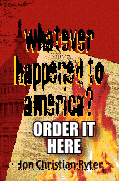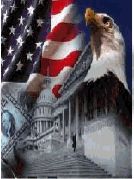
News
Behind the Headlines
Two-Cents Worth
Video of the Week
News Blurbs
Articles
Testimony
Bible Questions
Internet Articles (2015)
Internet Articles (2014)
Internet
Articles (2013)
Internet Articles (2012)
Internet Articles (2011)
Internet Articles (2010)
Internet Articles
(2009)
Internet Articles (2008)
Internet Articles (2007)
Internet Articles (2006)
Internet Articles (2005)
Internet Articles (2004)
Internet Articles (2003)
Internet Articles (2002)
Internet Articles (2001)

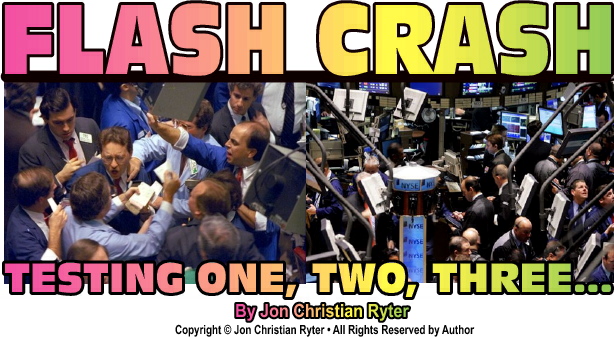
 hursday,
May 6th's gut-wrenching plunge on the big board scared traders on the
floor of the New York Stock Exchange [NYSE] when the Dow Jones Industrial
Average plummeted 998 points in afternoon trading because it appeared
that no one or nothing was manipulating the sell-off. NYSE boss Duncan
Niederauer made the decision to suspend trading for a few minutes,
a decision Bob Greifeld, head of the Nasdaq market believes momentarily
took NASDAQ to the abyss as 296 NASDAQ stocks tanked. Several stocks that
had been selling for $40 to $50 per share dropped to a penny.
hursday,
May 6th's gut-wrenching plunge on the big board scared traders on the
floor of the New York Stock Exchange [NYSE] when the Dow Jones Industrial
Average plummeted 998 points in afternoon trading because it appeared
that no one or nothing was manipulating the sell-off. NYSE boss Duncan
Niederauer made the decision to suspend trading for a few minutes,
a decision Bob Greifeld, head of the Nasdaq market believes momentarily
took NASDAQ to the abyss as 296 NASDAQ stocks tanked. Several stocks that
had been selling for $40 to $50 per share dropped to a penny. 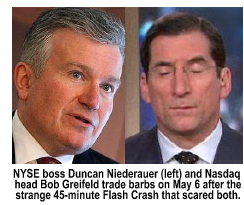 The
stock market freefall was compounded by the programmed electronic trading
system that automatically moves millions of shares of stock at warp speed.
The flash crash took the markets to the financial abyss, yet there appeared
to be no clear explanation why the Dow suddenly lost 6% of its value—just
shy of 1,000 points—in the most volatile, intraday move in the history
of the stock market; or why 296 NASDAQ stocks lost over 60% of their value
in minutes. After initially blaming the volatile financial situation in
Greece for the flash crash, the "experts" finally concluded
that, most likely, the sudden drop in the market may have been caused
by the computerized trading algorithms that automatically trigger trades
as stocks spike up or down. Many
of the brokers making electronic transactions are hedge funds that profit
from short selling stocks.
The
stock market freefall was compounded by the programmed electronic trading
system that automatically moves millions of shares of stock at warp speed.
The flash crash took the markets to the financial abyss, yet there appeared
to be no clear explanation why the Dow suddenly lost 6% of its value—just
shy of 1,000 points—in the most volatile, intraday move in the history
of the stock market; or why 296 NASDAQ stocks lost over 60% of their value
in minutes. After initially blaming the volatile financial situation in
Greece for the flash crash, the "experts" finally concluded
that, most likely, the sudden drop in the market may have been caused
by the computerized trading algorithms that automatically trigger trades
as stocks spike up or down. Many
of the brokers making electronic transactions are hedge funds that profit
from short selling stocks.
The White House issued a statement saying, "We saw what was happening in the markets as it happened. But aside from the blip, markets seemed to function pretty well. Obviously, it is all happening against a backdrop of fear over the Greek situation." Close, but no cigar. While the markets of the world like its banks and currencies are interlocked assuring that, like dominos, if one market collapses all of them are at risk of failing, Greece did not cause the May 6 Flash Crash. If anything, call it a "test run" that I believe was deliberately triggered by the nation's largest investment banks and brokerage houses using the computerized trading systems to see just how much control they possessed to collapse or restore the stock market; and also to see if floor traders could manually challenge or circumvent the computer trading algorithms. The money barons learned that the Dow can by shutting down the market and suspending trading. But, they know that's a temporary fix that works only as long as trading is suspended.
For five days prior to the Stock Market Crash of 1987 the market teetered, and like a volcano about to erupt, signaled that the mighty Dow was about to experience a financial trauma. From Wed., Oct. 14 to Mon., Oct. 19, 1987 the rumblings warned that the market was going to correct itself as the Dow shed 30% of its value. On Black Monday, the Dow plummeted 508 points, losing 22.6% of its value in one day. The S&P 500 dropped 20.4%, falling from 282.7 to 225.06. Percentage-wise, it was the greatest one day loss in the history of Wall Street to date.
And, like May 6, 2010, the experts were "trying" to sort out what happened. A number of explanations were offered. Among the explanations were computer trading, derivative securities (the futures market), illiquidity (not enough buyers to accommodate the sellers), overvaluation and, of course, trade and budget deficits that would let the brokers off the hook. Short selling was illegal in 1987, so we can't blame short sellers for the 1987 crash.
But we can blame the derivatives
buyers. The culprits in 1987 were derivatives and computerized programmed
trading. The primary catalyst was, and always is, greed. The greediest
players in the market are the derivatives buyers and the short sellers.
Derivatives play a major role in market volatility because derivatives
buyers are not current "buyers." 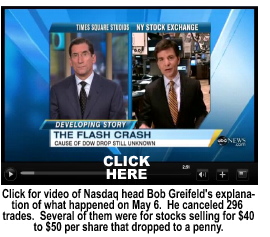 Derivative
buyers attempt to manipulate the value of stocks down the road by betting
on whether that stock, or the value of the commodity it represents, will
rise or fall in value. Once the derivatives buyers stake their claim,
they will do everything they can to manipulate the market to favor of
their position. Add to that equation computer trading and you have a volatile
mix. Add short selling and you have a recipe for disaster.
Derivative
buyers attempt to manipulate the value of stocks down the road by betting
on whether that stock, or the value of the commodity it represents, will
rise or fall in value. Once the derivatives buyers stake their claim,
they will do everything they can to manipulate the market to favor of
their position. Add to that equation computer trading and you have a volatile
mix. Add short selling and you have a recipe for disaster.
What happened on May 6 had the appearance of a covert "test" to see if programmed trading could either trigger a controlled collapse of the market, or stop an unintended market crash in the United States caused by catalysts in Europe or Asia. The May 6 Flash Crash began about 2:30 p.m. The panic lasted 45 minutes, until 3:15 p.m. Within the next 45 minutes, until the market closed at 4:00 p.m., stocks rebounded and the market gained nearly 400 points, closing at 10,520.32, down 347.80.
If you compare what happened in October, 1929 to what happened in October, 1987 and also with what triggered the volatility that set the stage for the Flash Crash of May 6, you must observe that the catalyst which created the Recession of 1929-32 and the Great Depression of 1933-42 was absent in 1987 but is present today. What does that mean? It means we are positioned to repeat the history we failed to learn from. Remember this about the Crash of 1929. The economy fired a warning shot over the bow of the USS Free Enterprise System in August, 1929—two months before the Crash. Everyone ignored the warning. Think of the May 6 Flash Crash as the latest warning shot fired over the bow of the USS Free Enterprise System. Clearly the Flash Crash happened because someone is planning something—just as they were in the summer of 1929 when the money barons were slowly moving their assets out of the stock market, leaving just enough behind to prime the suction pumps that drained the life out of the market.
What was the catalyst, or element, that caused the Crash of 1929 to become a full blown recession that bottomed out in June, 1932 and was rebounding by September of that year? The bankers who deliberately triggered the Stock Market Crash of 1929 also deliberately froze lending. Credit was virtually unavailable to the working class consumers. Does that sound familiar?
Without credit, consumer spending slowed significantly. With a greatly reduced demand for consumer goods, factories shut down or greatly reduced their labor forces, draining the economy of all non-borrowed consumer spending and exacerbating unemployment. In 1930, unemployment rose from 3.2% to 8.7%, slowly draining consumer dollars from the marketplace. In 1931, as more factories closed and more workers lost their jobs, unemployment rose to 15.9%.
Hoover pleaded with the bankers and Congress to jumpstart the economy by making credit available to consumers, many of whom had either lost or used up their life savings and were now losing their homes. Congress ignored Hoover. So did the banks, which were already prepping their 1932 presidential candidate, New York Gov. Franklin D. Roosevelt, with the talking points he would need to take the White House. The national emergency the banks had created would radically change the face of the United States. The GNP, which dropped 9.4% between October, 1929 and December, 1930, dropped another 8.5% in 1931. The money supply contracted 31%. Capital growth investments dropped from $16.2 billion to $335 million between the Crash and the spring of 1932 and unemployment rose to 23%.
In June the stock market began to rebound after Congress responded to Hoover pleas, creating the Reconstruction Finance Corporation to shore up banks and farm mortgage companies in order to provide a steady stream of credit to jumpstart the economy. The plan to infuse the economy with up to $2 billion in tax dollars was opposed by Hoover's Treasury Secretary, Andrew Mellon who was part of the group of bankers who created the economic meltdown in order to complete the transition of America started by social progressive Woodrow Wilson.
In an interesting parallel, the TARP legislation enacted by former President George W. Bush was strategized by his Treasury Secretary Henry Paulson. The methodology of the Reconstruction Finance Corporation was structured by the Democrats who became the majority party in 1930 and, in 1932, were already taking their marching orders from the bankers who would elect Franklin D. Roosevelt in November of that year. Heading the Reconstruction Finance Corporation was a banker named Charles G. Dawes, who was the first Director of the Budget when the office was established in 1921. Dawes was Calvin Coolidge's vice president in 1925.
The Franklin Delano Roosevelt social progressives in 1932, like the Barack Hussein Obama social progressives in 2008, argued that the relief effort was going to the wrong end of the economic ladder. The Democratically-controlled Congress wanted the funds of the Reconstruction Finance Corporation used to provide assistance for the poor. They built a transparency code into the Reconstruction Finance Corporation that required any bank applying for a loan to be publicly identified. As a result, whenever a bank applied for a loan, it triggered a run on that bank, defeating the purpose of the legislation and working against economic recovery which the social progressives did not want to happen. They intended to complete the transformation of the United States that was started by Woodrow Wilson in 1920 to make the United States a faceless State in a United World governed by the League of Nations.
To Americans in 1932 like
the American people in 2008-10 the RFC, like TARP, was viewed by the working
class as a relief program for big business. It was his vote in favor of
TARP that caused three term Utah Senator Robert Bennett to lose
his bid for a 4th term on May 8 in the Republican Party's State Nominating
Convention. Two Tea party activists who have never held political office
were picked by the GOP to run for the nomination in Utah's primary were
Mike Lee, a lawyer, and Tim Bridgewater, a businessman.
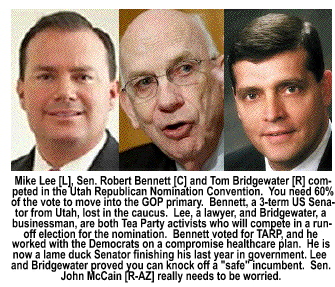 Neither
received the required 60% of the vote to secure the nomination and avoid
a run-off election. In addition to TARP, Bennett worked with Sen.
Ron Wyden [D-OR] on a compromise healthcare bill, which most Americans
see as an euthanasia bill to kill the elderly in order to salvage Social
Security by eliminating its recipients. Note: if the people of Utah do
not get out in force and support whichever of these men they nominate,
one of the most conservative States in the country will have a Democratic
Senator in November. Replacing an incumbent with a new face means the
money barons will throw tons of money on the incumbent on the other side
of the aisle.
Neither
received the required 60% of the vote to secure the nomination and avoid
a run-off election. In addition to TARP, Bennett worked with Sen.
Ron Wyden [D-OR] on a compromise healthcare bill, which most Americans
see as an euthanasia bill to kill the elderly in order to salvage Social
Security by eliminating its recipients. Note: if the people of Utah do
not get out in force and support whichever of these men they nominate,
one of the most conservative States in the country will have a Democratic
Senator in November. Replacing an incumbent with a new face means the
money barons will throw tons of money on the incumbent on the other side
of the aisle.
During the 2008 presidential election, Sen. Joe Biden, Obama's running mate, compared the Election of 2008 to the Election of 1932 and the battle between Franklin D. Roosevelt and Herbert Hoover. FDR's "New Deal" became Obama's "Change." Alaska Gov. Sarah Palin, Obama's running mate warned her audiences that the nation could be on a path to the Great Depression. Both candidates knew that unpopular change comes only through extreme adversity.
What stymied Hoover's attempt to stimulate the economy by infusing it with credit provided by the banks was a tax hike that raised the top income tax rate from 35% to 68% and new tariffs on consumer goods. (I guess that's like creating $2.3 trillion of new debt and then throwing in national healthcare to make sure the Obamaites financially cripple the American people for decades.) The reaction of the American worker in 1932 was no different than the reaction of today's American workers. What happened to a traditionally conservative US Senator who was believed to have a safe seat shows that no member of Congress on either side of the aisle is safe as the American people signal they are prepared to replace every incumbent in both Houses of Congress to repeal the laws enacted by Obama and to restore America's status quo.
The left knows this as well. They know something that communists in the Soviet Union and Nazis in Germany learned early in the 20th century that allowed them to steal two nations. Hungry people will always trade freedom for food. Quite possibly the Flash Crash of May 6, 2010 was a test drive for an October, 2010 market plunge that could make Black Tuesday, Oct. 29, 1929 look like a pimple on the butt of the Dow Industrials. Whether they use it in 2010 or save it for 2012 remains to be seen. But, the American people are now fighting back and the social progressives who are poised to erase the Constitution of the United States and create a totalitarian nation that will not resist world government, are not about to let the prize slip through their fingers.
While the media claims the May 6 market chaos was the result of a "fat finger," or "trader error," or just a glitch in the computer programmed trading system, I am reminded of something Franklin D. Roosevelt said. "In politics, nothing happens by accident. If it happens, you can bet it was planned that way." May 6 was a test. It was a controlled crash—a 45-minute test flash crash—to see if someone could electronically manipulate the market and simulate a crash and then, just as quickly, repair the damage electronically. It was not an error. It was not a glitch. It was a deliberate, contrived action—a test run. Test drives usually precede real events with real, detrimental consequences.

Copyright © 2009 Jon Christian Ryter.
All rights reserved.

